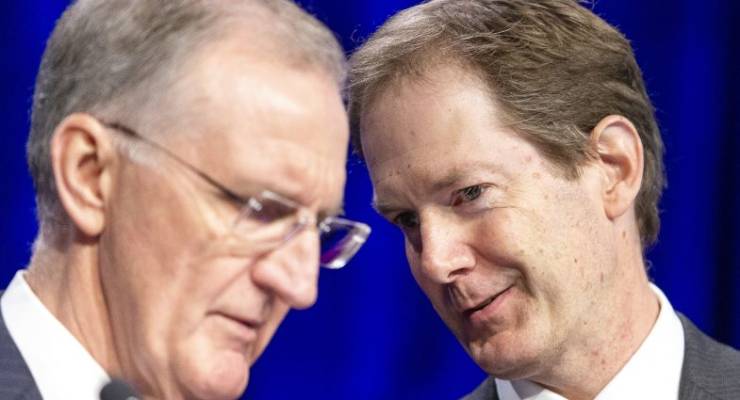
Interim executive chairman Mike Wilkins (left) and acting general counsel David Cullen.
Could AMP have played the tactics around its 2018 AGM any worse? It’s hard to think how.
Firstly, the culture clearly did not lend itself to transparency and openness, so Ken Hayne’s royal commission was able to deliver the most significant “gotcha” hit it has achieved so far with the revelations around the Clayton Utz report and lying to ASIC.
That in turn triggered a blizzard of publicity and a share price spiral which saw the stock hit a new 6 year low of $3.88 in morning trade. Clearly there is concern about the latest reports suggesting AMP’s financial advice division is rotten to the core and facing a harsh regulatory intervention from ASIC in the form of banning those all-important grand-fathered commissions.
The timing of the royal commission implosion was terrible in terms of the AGM cycle as AMP is the only major financial house with a December 31 balance date, hence the notice of meeting went out on March 26, coinciding with an announcement on the same day that CEO Craig Mellor would be out by the end of the year. However, despite Mellor’s handsome $8 million pay packet in 2017 and his impending “retirement”, all parties agreed to include another request for a big long term incentive grant to be included as part of the agenda. Big mistake.
Less than 4 weeks later, on April 20, AMP did their first big mea culpa to the ASX and marched Mellor out the door with immediate effect, appointing Mike Wilkins as acting CEO. However, there was no sign of any boardroom accountability.
It was clear chair Catherine Brenner was toast at this point, but the board failed to move against her, losing a critical 10 days until she was finally forced out on April 30, just 10 days before the AGM.
But that announcement defiantly declared the board had done nothing wrong and Group General Counsel Brian Salter was thrown under the bus. Strangely, the board did not lock Salter into a confidential settlement, so he came out swinging in the press, which is unheard of for an in-house lawyer at an ASX50 company.
Remarkably, the board declared they were only looking to appoint one new director, just as three incumbents were seeking mandates to serve for another 3 years.
When Brenner went on April 30, the longest serving director, Patti Akopiantz, should have resigned as well, making it more difficult for the proxy advisers and institutional investors to go ahead and vote the last two female directors off the board.
Instead, she stuck it out, but then resigned in sympathy with her defeated colleagues once the proxy votes were all in on Tuesday.
The board could have saved themselves by publiclly committing to all directors standing for election at the 2019 AGM – but they rejected that request from some of their angry institutional shareholders. Another huge tactical mistake!
The decision to announce David Murray as chair-elect at 3pm last Friday was a last desperate act by the board to save the 3 incumbents directors from an unprecedented ejection from the board.
However, this was announced after most of the proxy votes had already been cast. Murray then did media interviews over the weekend effectively saying “I’m the saviour so please do as I say and support all the directors.”
The board could have toughed it out by disclosing the proxy votes on Tuesday along with Patti Akopiantz’s resignation, a commitment to put everyone up for election in 2019 and then a plea for key institutional shareholders to switch their votes on the floor of the meeting in order to avoid leaving the company with an all male board.
But instead, the three remaining females all walked the plank and the whole board conspired not to disclose the proxy position showing a clear majority of votes against Holly Kramer and Vanessa Wallace, whilst the newest director, Andrew Harmos, survived.
The lack of transparency only got worse at yesterday’s AGM.
David Murray was a no show and “acting executive chairman” Mike Wilkins refused to even disclose how much he would be paid to chair the company.
Requests to see the proxies before the debate on the remuneration report and the re-election of Andrew Harmos were also rejected.
A total of 30 shareholders contributed to the debate at the two and a half hour AGM – including an unprecedented five online questions through the webcast which were read out by the company secretary.
However, the board refused to make themselves available to the media or shareholders after the AGM, literally skulking out through a door behind the stage in the Savoy Ballroom of the Grand Hyatt after suffering the second biggest remuneration report protest vote of any ASX50 company, after Telstra’s 66% in 2007.
A sumptuous feast was provided to the shareholders which would have fed twice the number of shareholders than actually showed up, but the overall message was one of a leaderless company in the bunker and on the run.
This is not going to end well.








It would even be an improvement if the corporates could make new mistakes, instead of same-old, same-mould.
As usual, Mayne shows how reportage is done – get the facts, assemble and explain to the rest of us.
It’s not much of a surprise. AMP’s main advantage in recent times has been their momentum. 40-50 years ago, it seemed everyone had some sort of life/super account – AMP have banked on that, doing everything they can do to not rock the boat, spending much of their advertiser on brand (rather than product) promotion. These days the only people I know with AMP products are only those which have been too lazy to change. Now that the searchlight’s on them, I reckon they’re toast.
20+ years ago when I refactored my super, I looked at AMP products and rejected them almost immediately, along with a few other ‘dinosaurs’. No only did they underperform against their competitors, but they had other delights like a 5% entry fee.
And yet over a third of AMP shareholders voted FOR the remuneration report! Can someone explain this, please?